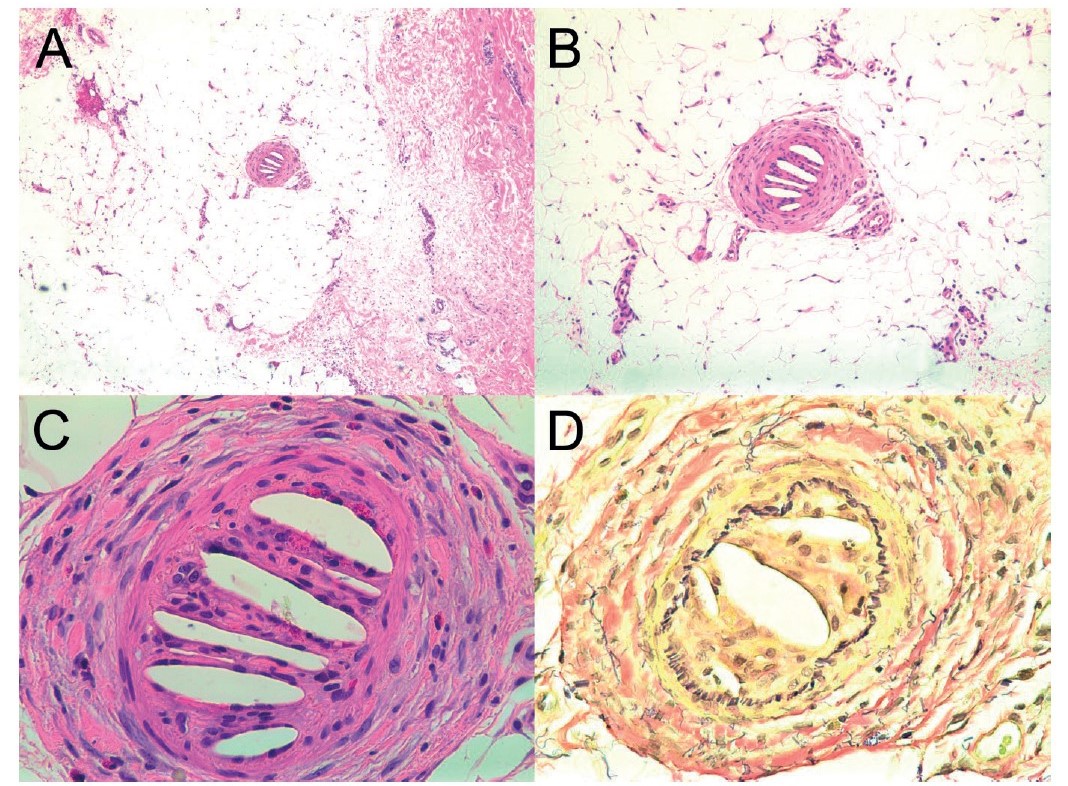Cholesterol Embolism after Cardiac Catheterization: A Case Report and Literature Review
Main Article Content
Abstract
Aging is the major risk factor for atherosclerosis and cardiovascular disease. As aging population increases, more patients develop coronary artery disease requiring diagnostic and therapeutic interventions such as coronary artery angiogram and angioplasty. One of the complications of such procedure is the rupture of cholesterol plaque. The cholesterol emboli can travel to more distal part of the arteries causing obstruction leading to organ ischemia as well as inflammation. If the emboli occludes renal arterial system, acute kidney injury or acute kidney disease may be the results. Patients typically present with progressive decline in renal function in association with ischemia of the skin and/or other organs. Making a diagnosis of cholesterol embolism requires high clinical suspicion in susceptible patients who undergo major cardiovascular procedure.
Article Details

This work is licensed under a Creative Commons Attribution-NonCommercial-NoDerivatives 4.0 International License.
This article is published under CC BY-NC-ND 4.0 license, which allows for non-commercial reuse of the published paper as long as the published paper is fully attributed. Anyone can share (copy and redistribute) the material in any medium or format without having to ask permission from the author or the Nephrology Society of Thailand.
References
Flory CM. Arterial Occlusions Produced by Emboli from Eroded Aortic Atheromatous Plaques. Am J Pathol. 1945 May;21(3):549–65.
Doty JR, Wilentz RE, Salazar JD, Hruban RH, Cameron DE. Atheroembolism in cardiac surgery. Ann Thorac Surg. 2003 Apr;75(4):1221–6.
Scolari F, Ravani P. Atheroembolic renal disease. The Lancet. 2010 May 8;375(9726):1650–60.
Saklayen MG, Gupta S, Suryaprasad A, Azmeh W. Incidence of atheroembolic renal failure after coronary angiography. A prospective study. Angiology. 1997 Jul;48(7):609–13.
Blauth CI, Cosgrove DM, Webb BW, Ratliff NB, Boylan M, Piedmonte MR, et al. Atheroembolism from the ascending aorta. An emerging problem in cardiac surgery. J Thorac Cardiovasc Surg. 1992 Jun;103(6):1104–11; discussion 1111-1112.
Jucgla A, Moreso F, Muniesa C, Moreno A, Vidaller A. Cholesterol embolism: Still an unrecognized entity with a high mortality rate. J Am Acad Dermatol. 2006 Nov;55(5):786–93.
Scolari F, Tardanico R, Zani R, Pola A, Viola BF, Movilli E, et al. Cholesterol crystal embolism: A recognizable cause of renal disease. Am J Kidney Dis. 2000 Dec;36(6):1089–109.
Ozkok A. Cholesterol-embolization syndrome: current perspectives. Vasc Health Risk Manag. 2019 Jul;Volume 15:209–20.
Lye WC, Cheah JS, Sinniah R. Renal Cholesterol Embolic Disease. Am J Nephrol. 1993;13(6):489–93.
Meyrier A. Cholesterol crystal embolism: diagnosis and treatment. Kidney Int. 2006 Apr;69(8):1308–12.
Lai CK, Randhawa PS. Cholesterol embolization in renal allografts: a clinicopathologic study of 12 cases. Am J Surg Pathol. 2007 Apr;31(4):536–45.
Belenfant X, Meyrier A, Jacquot C. Supportive treatment improves survival in multivisceral cholesterol crystal embolism. Am J Kidney Dis. 1999 May;33(5):840–50.
Bunt TJ. The clinical significance of the asymptomatic Hollenhorst plaque. J Vasc Surg. 1986 Dec 1;4(6):559–62.
Thadhani RI, Camargo CA, Xavier RJ, Fang LS, Bazari H. Atheroembolic renal failure after invasive procedures. Natural history based on 52 histologically proven cases. Medicine (Baltimore). 1995 Nov;74(6):350–8.
Scolari F, Ravani P, Gaggi R, Santostefano M, Rollino C, Stabellini N, et al. The Challenge of Diagnosing Atheroembolic Renal Disease. Circulation. 2007 Jul17;116(3):298–304.
Modi KS, Rao VK. Atheroembolic Renal Disease. J Am Soc Nephrol. 2001;7.
Andò G, Cortese B, Russo F, Rothenbühler M, Frigoli E, Gargiulo G, et al. Acute Kidney Injury After Radial or Femoral Access for Invasive Acute Coronary Syndrome Management: AKI-MATRIX. J Am Coll Cardiol. 2017 May 11;S0735-1097(17) 36897-3.
Scolari F, Ravani P, Gaggi R, Santostefano M, Rollino C, Stabellini N, et al. The challenge of diagnosing atheroembolic renal disease: clinical features and prognostic factors. Circulation. 2007 Jul 17;116(3):298–304.
Kronzon I, Saric M. Cholesterol Embolization Syndrome. Circulation. 2010 Aug 10;122(6):631–41.
European Association for the Study of the Liver. Electronic address: easloffice@easloffice.eu, Clinical practice guidelines panel, Wendon, Panel members, Cordoba J, Dhawan A, et al. EASL Clinical Practical Guidelines on the management of acute (fulminant) liver failure. J Hepatol. 2017 May;66(5):1047–81.
Mann SJ, Sos TA. Treatment of atheroembolization with corticosteroids. Am J Hypertens. 2001 Aug 1;14(8):831–4.
Nakayama M, Izumaru K, Nagata M, Ikeda H, Nishida K, Hasegawa E, et al. The Effect of Low-Dose Corticosteroids on Short- and Long-Term Renal Outcome in Patients with Cholesterol Crystal Embolism. Ren Fail. 2011 Apr 1;33(3): 298–306.
Ishiyama K, Sato T, Taguma Y. Low-Density Lipoprotein Apheresis Ameliorates Renal Prognosis of Cholesterol Crystal Embolism. Ther Apher Dial. 2015 Aug;19(4):355–60.


